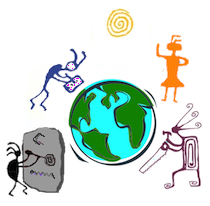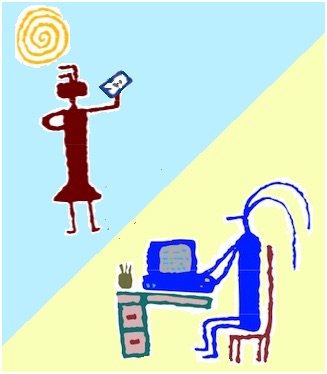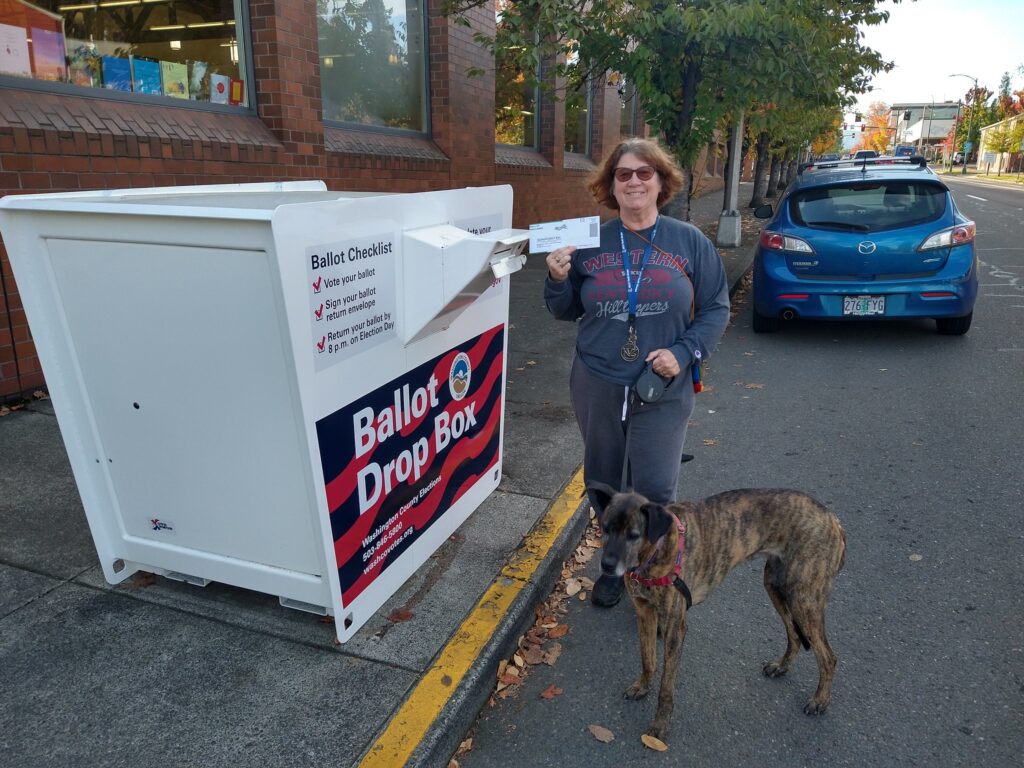
I’m back from my week-long stint volunteering as a part of Habitat for Humanity’s Global Village program, where I helped build a foundation for a house for a family in a low-income community outside of Asunción, Paraguay.
I wrote about the trip for the local Habitat affiliate I work for, part-time, here in Oregon, focusing on what we did day-to-day, how we built the foundation, challenges we faced, what I packed, how I fundraised for the trip, etc., along with tips for anyone who might want to explore being a team leader for such a trip in the future. But I wanted to write about the trip from the perspective of me the volunteer management consultant and researcher, and me the skeptic regarding most volunTOURism trips.
What is volunTOURism? It’s where a person pays a lot of money to travel somewhere for a volunteering experience. Habitat for Humanity would REALLY like to move away from this label, and I respect that – however, by the definition I use, that’s still what this program is. And that’s NOT something to be ashamed of: this is ethical voluntourism.
I used to think all volunTOURism – all instances where someone pays to volunteer abroad – was bad, period. People in the United Nations and working for other international development agencies tend to look down on people paying to volunteer, mostly because it can often seem to be all about the volunteer and their feel-good, photo-friendly experience (“Vanity Volunteering”), not about actually engaging in sustainable development, in activities that empower local people, that aren’t just charity, and it often can reinforce the worst ideas of white saviorism and colonialism. Some volunteering programs can take away jobs from local people (an example is the backlash against volunteers coming into NOLA after Hurricane Katrina from carpenters, roofers and others who were desperate for work).
More dire horror stories about volunTOURism abound: so-called wildlife sanctuaries that care for orphan animals, but the animals are orphaned because their parents have been killed so that the sanctuary has baby animals for the foreign volunteers to care for. So-called orphanages where, in many cases, children have parents, but parents are paid for their children to live in these “orphanages”, and foreigners come for a few days or weeks to “care for” the “orphans.” And cases where volunteers harm people they are supposed to be caring for, including harming women and children in the worst ways imaginable.
(You can read all my blogs about volunTOURism here. And you can read my resources for all kinds of volunteering abroad here.)
I started to change my mind about all volunTOURism being all bad when I noticed a few programs that seemed to be designed by local people themselves, where there were written standards for both volunteers and for the kinds of work volunteers could, and shouldn’t, engage in, where there were strict rules regarding safety and safeguarding for both volunteers and those served, and where the work by the volunteers was needed and not being done by anyone else. Like Africa Fire Mission, a nonprofit that brings together experienced firefighters from developed countries to train firefighters in various African countries regarding effective emergency response and fire prevention and response services. Or HistoriCorps, a program in the USA where volunteers pay a fee and help restore a historic site on public lands, sometimes in very remote places.
The one volunTOURism program that stood out most was the Global Village program by Habitat for Humanity. Through this program, local Habitat programs in impoverished areas in South America, Central America and Asia receive much needed funding, in part per the fees paid by international volunteers, and an intense, hyper-productive week of labor: the volunteers get an incredible amount done in a week, working right along side local contractors (which the volunteers’ fees have helped fund). The additional goals of the program are that there is an increased understanding by the visiting volunteers of home ownership challenges globally and the role Habitat for Humanity plays in such, that volunteers become better advocates for Habitat’s vision where everyone has a decent place to live, and that people from different cultures get to come together and work side-by-side, leading to greater understanding and appreciation of each other – what Habitat calls God’s love into action, what I call humanism in action and necessary for our survival.
In all my years as a volunteer management consultant, long before I started working for a Habitat affiliate here in Oregon, I was a fan of Habitat for Humanity and its model for volunteer engagement locally. Habitat fully acknowledges that it is not going to solve the housing crisis anywhere by volunteers coming together when they have some time and building some houses here and there; the much needed resolution in the global housing crisis will come only through drastic and impactful policy changes and enforcement of those changes. But those changes will come only through the will of a mass of people, and one of the best ways to get people on your side, to turn people into advocates for your cause, is to get them involved as volunteers at your organization.
Habitat has strict guidelines for volunteer engagement on a local level, and when those principles are well applied, they are, IMO, the best in the “business” of volunteer engagement. Habitat’s engagement of groups of volunteers, when done in alignment with Habitat rules and policies, are models for other organizations. For the volunteer, the bar to participation should feel quick and easy, but behind the scenes, if done properly, a lot of thought, time and care goes into the volunteer feeling that way.
But what about Habitat’s volunteering-abroad program? How do I think it measures up in terms of ethics and impact? I’ll cut to the chase and it won’t be a surprise: this was a model group volunteering endeavor. This is the standard every short-term program should aspire to, whether it’s a local or international program:
- Volunteers were provided all the materials beforehand, with all the information they needed to know exactly what they were getting into.
- Volunteers were provided details on exactly what the money they had to raise, or pay, would pay for.
- Volunteers knew exactly what to pack, what would be provided and what would not.
- The group leader, also a volunteer, stayed in touch regularly, but not overwhelmingly, before departure. She sent regular reminders and had answers to all questions. And then after the trip, she sent an outstanding followup message that explained how we could continue to support Habitat and how we could get involved in advocacy efforts.
- A WhatsApp group was set up for all volunteers just before we departed, so we would know who was arriving when, we could easily share links to photos, and we could further build community (and trust) with each other (that makes this a virtual volunteering effort, BTW!).
- Volunteers always knew where to be and when to be there.
- We were warmly welcomed at the work site.
- The work was ready for the volunteers to do immediately, every day.
- There were several people providing guidance whenever needed.
- The safety and safeguarding briefing was clear and provided exactly the information needed, clearly and without any ambiguity.
- Volunteers’ time was never, ever wasted.
- Drinking water was provided (I can’t believe how many group endeavors don’t provide this).
- A bathroom was provided (again, I can’t believe how many group endeavors don’t have this).
- The volunteers worked like freakin’ machines. Unstoppable, ever-fueled machines. Get. Out. Of. Their. Way. The team leader definitely recruited exactly the right group for this gig (with one exception: me. I was no where near as productive as the other volunteers. But I had an excuse: I was so sick the week before that I almost had to cancel my trip, and the very strong antibiotics I was on those first days did NOT help).
In all fairness, I have to point out that this group of volunteers in Paraguay was full of ringers: there were 11 volunteers in all, and four were employees of Habitat for Humanity International, and all but two – and one of those two was me – were veterans of the Global Village program. So I was the only person starting from absolute zero. And given that I’m a rather seasoned international traveler, and a volunteer management consultant and trainer, I was a bit of a ringer myself.
But, of course, Habitat’s global volunteering program is more than a group volunteering gig abroad. It’s volunTOURism: volunteers are paying to go abroad and paying a fee to participate. How did THAT aspect measure up in terms of my oh-so-picky list of volunTOURism ethics?
Habitat’s Global Village program was put on hold during COVID so the program could be redesigned to be more locally-focused, more impactful for local communities, and less about tourism. I can’t compare my experience to before the pandemic. But here’s what I can say about my experience, in terms of the changes Habitat said they wanted to implement in the program:
In changing the program, Habitat said they wanted these volunteer activities to be focused on volunteers engaging in mutual learning and exchange with local people, rather than tourism activities. I think they nailed this. There were tourism activities, which took place on the day or two before work began, and in the evenings. But the focus of this trip was on the work itself, and the work took place right alongside the local contractors and local staff.
I was never so happy at my meager Spanish skills: I got to talk a lot with local staff, the local construction workers, the family we served and even some of the local kids gathered to watch. Each day when we arrived at the site, I would greet each member of the family that had come out to watch us work, holding hands, giving greetings and kissing each other on the cheek. One volunteer told me that, while I was feeling envious of the energy and strength of all the volunteers (I really was not nearly as productive as they were), she was envious of me having conversations with the Paraguayans. She said she felt like there was a wall between her and them, and she didn’t know how to bridge it, and she was envious every time I walked over and started chatting with local folks. I definitely got the “mutual learning and exchange with local people” aspect, but I’m not sure all the volunteers did (but those who didn’t were the ones why were hyper productive in building the foundation of this house, and that’s what they seemed to want to do most).
The redesigned program does not want international volunteers to enter a community with their own ideas of what needs to be done. The “agenda of change” needs to be defined by and led by the local people being served, not the outside volunteers coming into a community. I think this was adhered to, but not because volunteers were ever told this priority; the volunteers I was with in Paraguay were all veterans of these kinds of Habitat programs, save one person besides me, and they already knew better than to walk in to a work site and say things should be done differently.
Per the programs’ redesign, a promotion of safeguarding was supposed to be much more emphasized throughout the experience than before. I don’t know what it was like before, but I can say that what I experienced was a MODEL emphasis on and explanation of safeguarding and safety, one that the affiliate I work for still hasn’t mastered. Kudos.
Habitat Global Village projects are supposed to be designed by local communities and the focus should be on local ownership and local sustainability. They nailed this goal too. There was no doubt who was in charge – and it was NOT us, the volunteers – and whose project this was – NOT ours, but the local people themselves.
Also per the redesign of the program, from the beginning, volunteers were supposed to learn about the need for adequate housing around the world, so we can become advocates regarding the cause and champions for equitable housing long after their trip has ended. For me, this goal came up just a bit short. Why is there a shortage of housing in Paraguay? What policies and practices are keeping people from having housing in Paraguay? What’s the unemployment rate? How much would a family need to make to build their own house without NGO assistance? Are all kids in school? How does lack of housing affect education in Paraguay? Where is Paraguay in the UNDP Human Development Index? Where does it rank in Transparency International’s Corruption Perceptions Index? I don’t think it would have taken a huge amount of time to touch on answers to these questions, so we could get more context to why Habitat is needed in Paraguay (and other countries). But that said, the followup message from Habitat, after we returned, was spot on: it provided information on how we could be continued advocates for Habitat, how we could become involved with our local Habitat affiliates, etc. There’s an entire paragraph in my blog about the trip for the local Habitat affiliate I work for about advocacy and its importance, and it wouldn’t have been there had we not gotten this follow up email.
Personally, I felt uncomfortable at the stark contrast of our accommodations and our morning and evening meals to the lives of the people in the neighborhood where we worked in Paraguay. I’m a motorcycle traveler, including in developing countries, and I don’t stay in hotels as nice as what we experienced in Paraguay, and I don’t eat at restaurants nearly so nice when traveling. But from what I understand, our level of accommodations in Asunción were necessary because of the security situation in the region where we worked – we were very obviously a big group of relatively wealthy Americans, and we REALLY stood out in the countryside. As for the food at very nice restaurants, I think Habitat is dedicated to volunteers not getting sick, as they have just one week to work (and did I mention it is REAL WORK?). No one wants any volunteer to spend their week mostly in a hotel room bathroom. So, I get why our accommodations and food were as they were.
With all that said, let me be clear: this was an amazing experience. I cried when it was over. So. Much. Hugging. One of the local staff told me, “You were my favorite” and I nearly collapsed in weeping. This experience ticked all the boxes: international volunteers really were needed and really did make a difference, the effort was locally led, I know things about Paraguay I didn’t know before and I am in love with the country, I had an amazing experience, and I am even more committed to the mission of Habitat than I was before. I have a stronger connection to Habitat than ever before – and I intend to turn these feelings into more effective action at the affiliate where I work.
And a few days after I returned home, the homeowner that we had helped had “liked” my Facebook page, and written on one of the posts about Paraguay, “Gracias por todo Ojalá algún día vuelvan las puertas de mi casa siempre estará abiertas para todos ustedes Dios los bendiga.” (Thank you for everything I hope one day you come back the doors of my house will always be open to all of you God bless you.)
That comment, and so much of this experience, is what is too often missing almost entirely in professional international development work. I have worked for the United Nations three times. The first time was at a UN program HQ, and I rarely got this moving emotional experience there like I had in Paraguay, because I was so far removed from the people actually being served, and there were times that this kind of inspiration would have made me much more motivated – something very much needed amid the stress and bureaucracy of the UN work environment. When I worked in Afghanistan and Ukraine, I made a point to get beyond the office space, to get to know Afghans and Ukrainians, and as a result, I loved that field work so, so much more than HQ work. And I cried when I left those countries. And still cry for them.
When I worked at United Nations Volunteers HQ, part of UNDP, the head of UNV, Sharon Capeling-Alakija, said that the reason she was passionate about the UN’s Online Volunteering service, which I managed, was because it gave far more people a chance to be involved in the work of the UN. She felt it unfair that the ONLY way to be involved in the UN was to have a Master’s Degree, 10 years of experience and a job at a UN agency; she wanted a way for people with less experience, but with just as much interest and passion and good ideas, to get to be involved, to get an idea of what the UN does beyond what they read in the media, and maybe it could create a more caring world. Her words came back to me as I was a part of this Habitat experience. It’s still a rather exclusive experience: you have to pay all of your travel costs (or some angel in your life has to pay such for you) and you have to fundraise your program costs, or pay those yourself, and that means it’s not something just anyone can participate in. But it’s an avenue into working abroad with a much lower bar than getting a paid job and giving up your home and all your friends and family for a few years. And it really does have impact. It really does make a difference.
Any program that’s creating a greater feeling of solidarity and understanding among people, that cultivates empathy and caring and learning, is worth supporting, because oh how the world needs that right now.
Local volunteers in Paraguay will now begin to work on the site along those same wonderful contractors we worked with. The staff at Hábitat para la Humanidad Paraguay will update their Facebook and Instagram accounts about this family, so we – and YOU – will be able to see the progress and the finished product. They already have photos and videos there of our volunteer group in action.
And back here where I live in Oregon, I hope that we can incorporate the practices of Habitat Paraguay in making sure volunteers feel supported and prepared, that volunteers feel like they’ve made a real difference by the end of a day of work, and that they feel a part of Habitat for Humanity, so much so that they want to learn more about why there is a lack of affordable housing and why so many thousands and thousands of hard working people in our community cannot afford a house.
One more thing: there were a group of pre teens on bicycles, pretty rough, who came to watch us almost every day. They would call out words in English to see if we would respond. And one day, one of them yelled, “W.W.E!” That stands for World Wrestling Entertainment. One of the volunteers turned around and yelled back the name of a well-known wrestler. And BOOM, that volunteer was The Greatest American To Ever Visit This Village. The kids yelled wrestler names, the volunteer yelled back other wrestler names, imitating how the wrestlers get introduced in the ring. The kids could not get enough of him. At one point, I looked over and the volunteer was helping to repair one of the kid’s bicycles, with the kids all gathered around him. I bring this up because I have blogged about how much kids worldwide, from Kabul to Kansas, LOVE professional wrestling, and I cannot for the life of me understand why international development agencies and governments don’t leverage this. Yeah, People Magazine, I will never forgive you for all but mocking me when I dared to mention wrasslin’ in that project back we worked on in the 1990s…
Here’s my original announcement about this Paraguay trip.
And here’s a blog about Packing for Paraguay which I did primarily because I got paid for a product placement (SELLOUT!).
Habitat is seeking people to become Global Village Team Leaders. Candidates need to be from organized groups, such as university classes or clubs, social clubs, communities of faith, volunteers or staff from local Habitat affiliates, employees from a company, etc. Candidates take the Global Village online trainings and then lead their organized group of co-workers, club members, students, congregation members or other association on a Global Village program trip abroad. Visit the Global Village team leader FAQ to find out if leading a team is right for you. The option for independent volunteers to join teams with whom they do not already have an association is not currently available, but you should sign up at the Habitat web site for updates in case this changes.
New Global Village build dates for 2026 will be released in July! Now is the perfect time to take the team leader trainings and to talk to your co-workers, fellow students, fellow members of your community of faith, other members of your civic club, or your local Habitat affiliate where you already volunteer about this program, to generate interest among your associates for possibly joining your team. That will help you to be ready to book early and secure your team’s spot in the Habitat program. Global Village groups usually consist of up to 16 individuals. Potential participants should understand that each Global Village volunteer raises funds among their associates or contributes a donation ranging from US$1,625-$2,700 that supports Habitat’s housing programs. Volunteers are responsible for paying for their own on-site accommodations (arranged by Habitat), meals, ground transportation and transportation to the country, as well as arranging for any necessary visas.








